Synthesis, Molecular Structure, and Computational Studies of Dinuclear d0 Titanium(IV) Complex with P-P-Bonded Diphosphine Ligand
Abstract
1. Introduction
2. Results and Discussion
2.1. Synthesis and Structure of Dinuclear Titanium Complex 2: Reaction of Diphosphine 1 with Titanium Tetrachloride
2.2. Reaction of Diphosphine 1 with Titanium Tetra(isopropoxide)
2.3. Energy Comparison Between the Product and the Precursor Systems
2.4. UV-Vis Spectrum of 2
3. Experimental Section and Computational Details
3.1. General Procedures
3.2. Reaction of Diphosphane 1 with 2 Equivalent of TiCl4
3.3. Reaction of Diphosphane 1 with Ti(OiPr)4
3.4. Reaction of 2 with Methanol
3.5. X-Ray Crystallographic Studies for Dinuclear Titanium Complex 2
3.6. Computational Details
4. Conclusions
Supplementary Materials
Author Contributions
Funding
Institutional Review Board Statement
Informed Consent Statement
Data Availability Statement
Acknowledgments
Conflicts of Interest
References
- Quin, L.D. A Guide to Organophosphorus Chemistry; Wiley: New York, NY, USA, 2000. [Google Scholar]
- Kamer, P.C.J.; van Leeuwen, P.W.N.M. Phosphorus(III) Ligands in Homogeneous Catalysis: Design and Synthesis; Wiley: Chichester, UK, 2012. [Google Scholar] [CrossRef]
- Chaudret, B.; Delavaux, B.; Poilblanc, R. Bisdiphenylphosphinomethane in dinuclear complexes. Coord. Chem. Rev. 1988, 86, 191–243. [Google Scholar] [CrossRef]
- Puddephatt, R.J. Chemistry of bis(diphenylphosphino)methane. Chem. Soc. Rev. 1983, 12, 99–127. [Google Scholar] [CrossRef]
- Balch, A.L. Binuclear, Phosphine-Bridged Complexes: Progress and Prospects. In Homogeneous Catalysis with Metal Phosphine Complexes; Pignolet, L.H., Ed.; Modern Inorganic Chemistry; Springer: Boston, MA, USA, 1983; pp. 167–201. [Google Scholar] [CrossRef]
- Tam, E.C.Y.; Maynard, N.A.; Apperley, D.C.; Smith, J.D.; Coles, M.P.; Fulton, J.R. Group 14 Metal Terminal Phosphides: Correlating Structure with |JMP|. Inorg. Chem. 2012, 51, 9403–9415. [Google Scholar] [CrossRef] [PubMed]
- Rehder, D. Vanadaphospha-alkanes and -cycloalkanes Prepared by Photoreaction of Carbonyl-Vanadium Compounds with Tetraphenyldiphosphines. J. Organomet. Chem. 1977, 137, C25–C27. [Google Scholar] [CrossRef]
- Bechthold, H.-C.; Rehder, D. Preparation and Ir, 31P, and 93Nb NMR Spectroscopic Investigation of Phosphine Derivatives of η5-C5H5Nb(CO)4. J. Organomet. Chem. 1981, 206, 305–315. [Google Scholar] [CrossRef]
- Baumgarten, H.; Johannsen, H.; Rehder, D. Diphosphane, Diarsane und Distibane als Liganden in Carbonylvanadium-Komplexen. Chem. Ber. 1979, 112, 2650–2658. [Google Scholar] [CrossRef]
- Mizuta, T.; Kunikata, S.; Miyoshi, K. Synthesis and Molecular Structures of Dinuclear Complexes with 1,2-Dihydro-1,2-diphenyl-naphtho[1,8-c,d]1,2-diphosphole as a Bridging Ligand. J. Organomet. Chem. 2004, 689, 2624–2632. [Google Scholar] [CrossRef]
- Chatt, J.; Thompson, D.T. Dinuclear Phosphorus and Arsenic Bridged Carbonyl Compounds. Part II. J. Chem. Soc. 1964, 2713–2716. [Google Scholar] [CrossRef]
- Hayter, R.G. Phosphorus- and Arsenic-Bridged Complexes of Metal Carbonyls. VI. Reactions of Tetrasubstituted Biphosphines and a Biarsine with Monomeric Metal Carbonyls. Inorg. Chem. 1964, 3, 711–717. [Google Scholar] [CrossRef]
- Nassimbeni, L.R. The crystal structure of -tetraethyldiphosphine-bis-(pentacarbonylmolybdenum). Inorg. Nucl. Chem. Lett. 1971, 7, 187–189. [Google Scholar] [CrossRef]
- Brockhaus, M.; Staudacher, F.; Vahrenkamp, H.; Metallorganische Lewis-Basen, X. Aufbau von Diphosphin-verbrückten, heterodinuclearen Carbonyl-Komplexen des Chroms, Mo-lybdäns und Wolframs. Chem. Ber. 1972, 105, 3716–3725. [Google Scholar] [CrossRef]
- Staudacher, L.; Vahrenkamp, H. Metallorganische Lewis-Basen, XVII1) Hetero-Zweikernkomplexe des Typs (CO)5Cr-P(CH3)2-P(CH3)2-M. Chem. Ber. 1976, 109, 218–228. [Google Scholar] [CrossRef]
- Trenkle, A.; Vahrenkamp, H. Darstellung und Thermolyse P2Me4-verbrückter Mehrkern-Carbonylkomplexe. Chem. Ber. 1981, 114, 1366–1381. [Google Scholar] [CrossRef]
- Trenkle, A.; Vahrenkamp, H. Metallcarbonyl-Brückenligand-Sechsringsysteme. Chem. Ber. 1981, 114, 1343–1365. [Google Scholar] [CrossRef]
- Maigrot, N.; Charrier, C.; Richard, L.; Mathey, F. The 1,2-dihydro-1,2-diphosphete-1,4-diphosphadiene equilibrium. X-ray structures of [μ2,μ2,η1,η1-(Ph)8C4P4]W2(CO)6 and [μ1,μ1-(Ph)4C2P2]W2(CO)10. Polyhedron 1990, 9, 1363–1367. [Google Scholar] [CrossRef]
- Grobe, J.; Grosspietsch, T.; Van, D.L.; Schulze, J.; Krebs, B.; Dartmann, M. Perfluormethyl-element-liganden XXXIX. Chrompentacarbonylkomplexe von Diels-Alder addukten des bis(trifluormethyl)disphosphens. J. Organomet. Chem. 1990, 385, 255–275. [Google Scholar] [CrossRef]
- Kühl, O.; Blaurock, S.; Hey-Hawkins, E. Synthesis and molecular structure of [Li(THF)4][{(CO)4Mo}2(μ-PPh 2)(μ-PPh2PPh2)]: The first compound with an 1,3-dimetalla-cyclopentaphosphane ring. Z. Anorg. Allg. Chem. 1999, 625, 1517–1521. [Google Scholar] [CrossRef]
- Basato, M.; Brescacin, E.; Tondello, E.; Valle, G. Improved synthesis of the heteronuclear phosphido Mo–W complex [(CO)4Mo(μ-PMe2)2W(CO)4 ] and its use as MOCVD precursor. Inorg. Chim. Acta 2001, 323, 147–151. [Google Scholar] [CrossRef]
- Grobe, J.; Köhne-Wächter, M.; Le Van, D. Perfluormethyl-element-liganden: XXXI. Ligandeneigenschaften von Me2PP(CF3)2 und Me2AsP(CF3)2. J. Organomet. Chem. 1985, 280, 331–341. [Google Scholar] [CrossRef]
- Hinke, A.M.; Hinke, A.; Kuchen, W. Reactions of coordinated ligands II. Metal(0) carbonyl complexes with diphosphanes R(X)PP(X)R (R aryl; X Br, I, H, C4H9) as bridging ligands. J. Organomet. Chem. 1983, 258, 307–314. [Google Scholar] [CrossRef]
- Toda, T.; Kasahara, Y.; Iwasaki, J.; Wakatsuki, A.; Ohta, S.; Matano, Y.; Takenaka, K. A Zirconium Complex Bearing a [NPN] Tridentate Ligand Composed of Dibenzophosphole and Pyrrolide Moieties: Synthesis, Structure, and Ethylene-Polymerization Ability. Organometallics 2025, 44, 128–136. [Google Scholar] [CrossRef]
- Iwasaki, J.; Toda, T.; Wakatsuki, A.; Ohta, S.; Nishii, K.; Matano, Y.; Takenaka, K. Synthesis and Polymerization Activity of Phosphine-Pyrrolido [PN] Titanium and Zirconium Complexes. Appl. Organomet. Chem. 2025, 39, e7928. [Google Scholar] [CrossRef]
- Iwasaki, J.; Kasahara, Y.; Toda, T.; Takenaka, K. 1-Octene Polymerization Catalyzed by Titanium and Zirconium Complexes Supported by [PN] or [NPN] Ligands. Polymer J. 2025, 57, 635–643. [Google Scholar] [CrossRef]
- Iwasaki, J.; Toda, T.; Nishii, K.; Takenaka, K. Synthesis, Structure, and Polymerization Activity of [PN]2M(amido)2 (M = Ti and Zr) Complexes. Appl. Organomet. Chem. 2025, 39, e70072. [Google Scholar] [CrossRef]
- Nief, F.; Ricard, L. Synthesis of η¹ and η⁵ Complexes of Samarium(II) with Benzophospholyl Ligands. J. Organomet. Chem. 1994, 464, 149–154. [Google Scholar] [CrossRef]
- Decken, A.; Neil, M.A.; Dyker, C.A.; Bottomley, F. Iron Complexes of the Dibenzophospholyl Ligand: A Synthetic and Crystallographic Study. Can. J. Chem. 2002, 80, 55–61. [Google Scholar] [CrossRef]
- Decken, A.; Neil, M.A.; Bottomley, F. Synthesis and Characterization of Manganese Complexes of the Dibenzophospholyl Ligand. Can. J. Chem. 2001, 79, 1321–1329. [Google Scholar] [CrossRef]
- Chen, L.; Cotton, F.A.; Dunbar, K.R.; Feng, X.; Heintz, R.A.; Uzelmeir, C. Preparation, Molecular and Electronic Structures, and Magnetic Properties of Face-Sharing Bioctahedral Titanium(III) Compounds: [PPh4][Ti2(μ-Cl)3Cl4(PR3)2]. Inorg. Chem. 1996, 35, 7358–7363. [Google Scholar] [CrossRef] [PubMed]
- Hart, R.; Levason, W.; Patel, B.; Reid, G. Synthesis, Spectroscopic and Structural Studies on Six- and Eight-Coordinate Phosphane and Arsane Complexes of Titanium(IV) Halides. Eur. J. Inorg. Chem. 2001, 2001, 2927–2933. [Google Scholar] [CrossRef]
- Lee, K.; Wei, H.; Blake, A.V.; Donahue, C.M.; Keith, J.M.; Daly, S.R. Measurement of Diphosphine σ-Donor and π-Acceptor Properties in d⁰ Titanium Complexes Using Ligand K-Edge XAS and TDDFT. Inorg. Chem. 2018, 57, 10277–10286. [Google Scholar] [CrossRef]
- Burck, S.; Gudat, D.; Nieger, M. Diphosphanes with Polarized and Highly Reactive P−P Bonds. Angew. Chem. Int. Ed. 2004, 43, 4801–4804. [Google Scholar] [CrossRef] [PubMed]
- Arkhypchuk, A.I.; Orthaber, A.; Ott, S. Tuning the Optical Properties of 1,1′-Biphospholes by Chemical Alterations of the P–P Bridge. Eur. J. Inorg. Chem. 2014, 2014, 1760–1766. [Google Scholar] [CrossRef]
- Gorman, A.D.; Cross, J.A.; Doyle, R.A.; Leonard, T.R.; Pringle, P.G.; Sparkes, H.A. Phosphophosphidites Derived from BINOL. Eur. J. Inorg. Chem. 2019, 2019, 1633–1639. [Google Scholar] [CrossRef]
- Katsuki, T.; Sharpless, K.B. The First Practical Method for Asymmetric Epoxidation. J. Am. Chem. Soc. 1980, 102, 5974–5976. [Google Scholar] [CrossRef]
- Kumar, A.; Samuelson, A.G. Catalytic Reactions of Titanium Alkoxides with Grignard Reagents and Imines: A Mechanistic Study. Chem. Asian J. 2010, 5, 1830–1837. [Google Scholar] [CrossRef]
- Ramachandran, P.V.; Gagare, P.D.; Sakavuyi, K.; Clark, P. Reductive Amination Using Ammonia Borane. Tetrahedron Lett. 2010, 51, 3167–3169. [Google Scholar] [CrossRef]
- Grasset, F.; Cazaux, J.-B.; Magna, L.; Braunstein, P.; Oliver-Bourbigou, H. New Bis(aryloxy)–Ti(IV) Complexes and Their Use for the Selective Dimerization of Ethylene to 1-Butene. Dalton Trans. 2012, 41, 10396–10404. [Google Scholar] [CrossRef]
- Sheldrick, G.M. Crystal structure refinement with SHELXL. Acta Crystallogr. C 2015, 71, 3–8. [Google Scholar] [CrossRef]
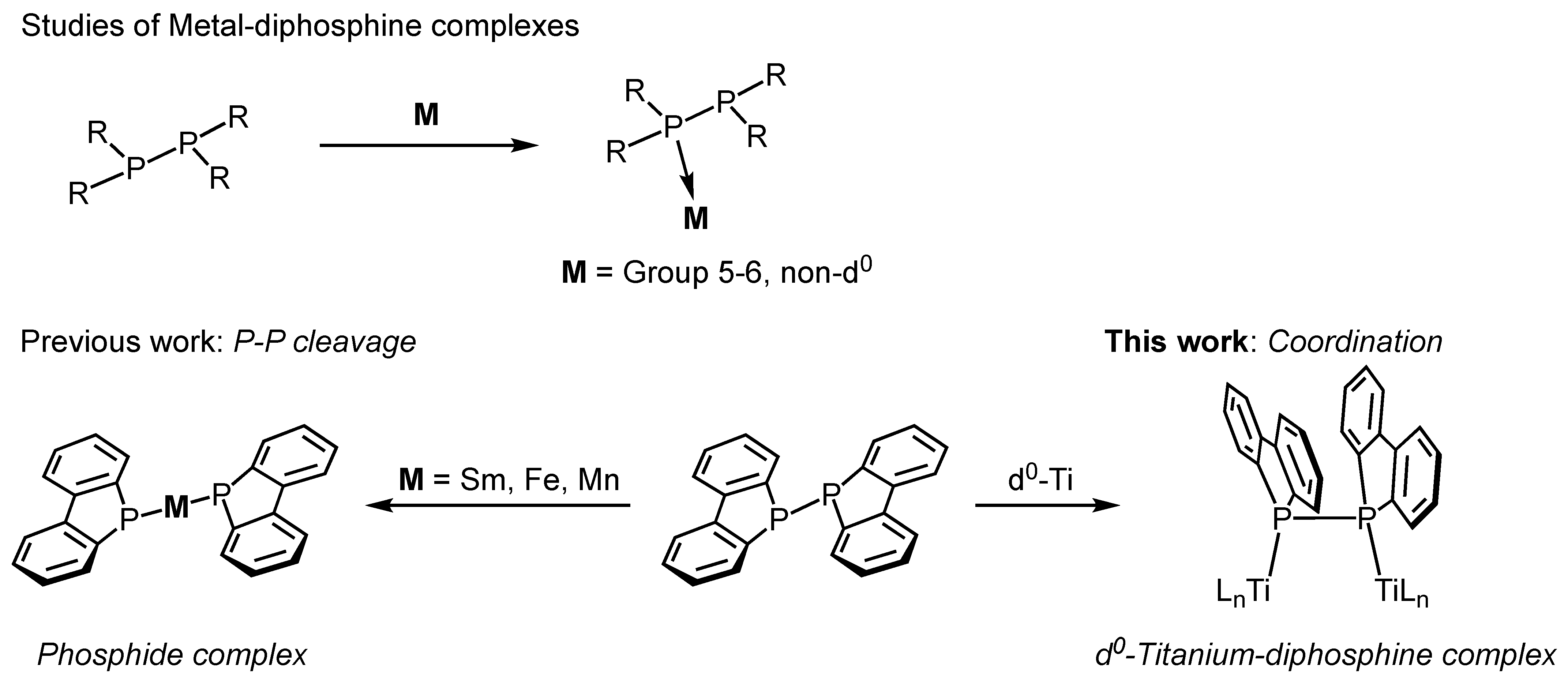
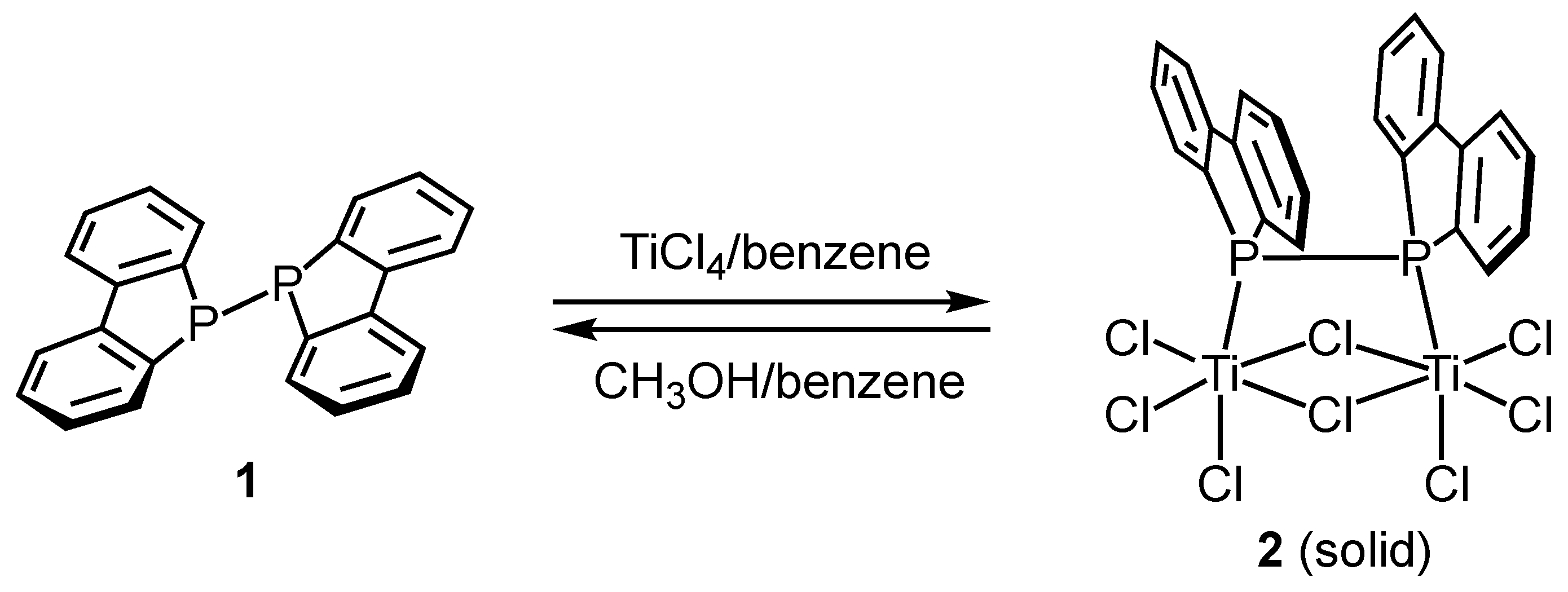


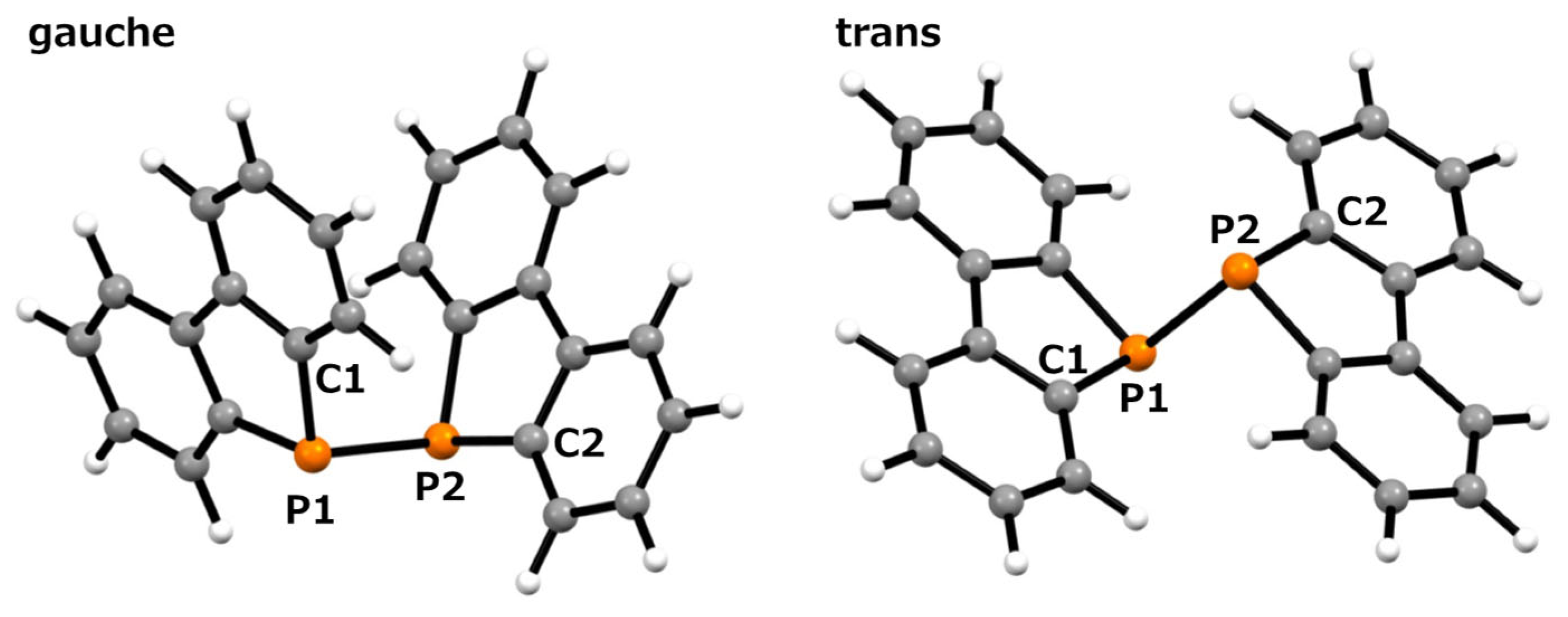

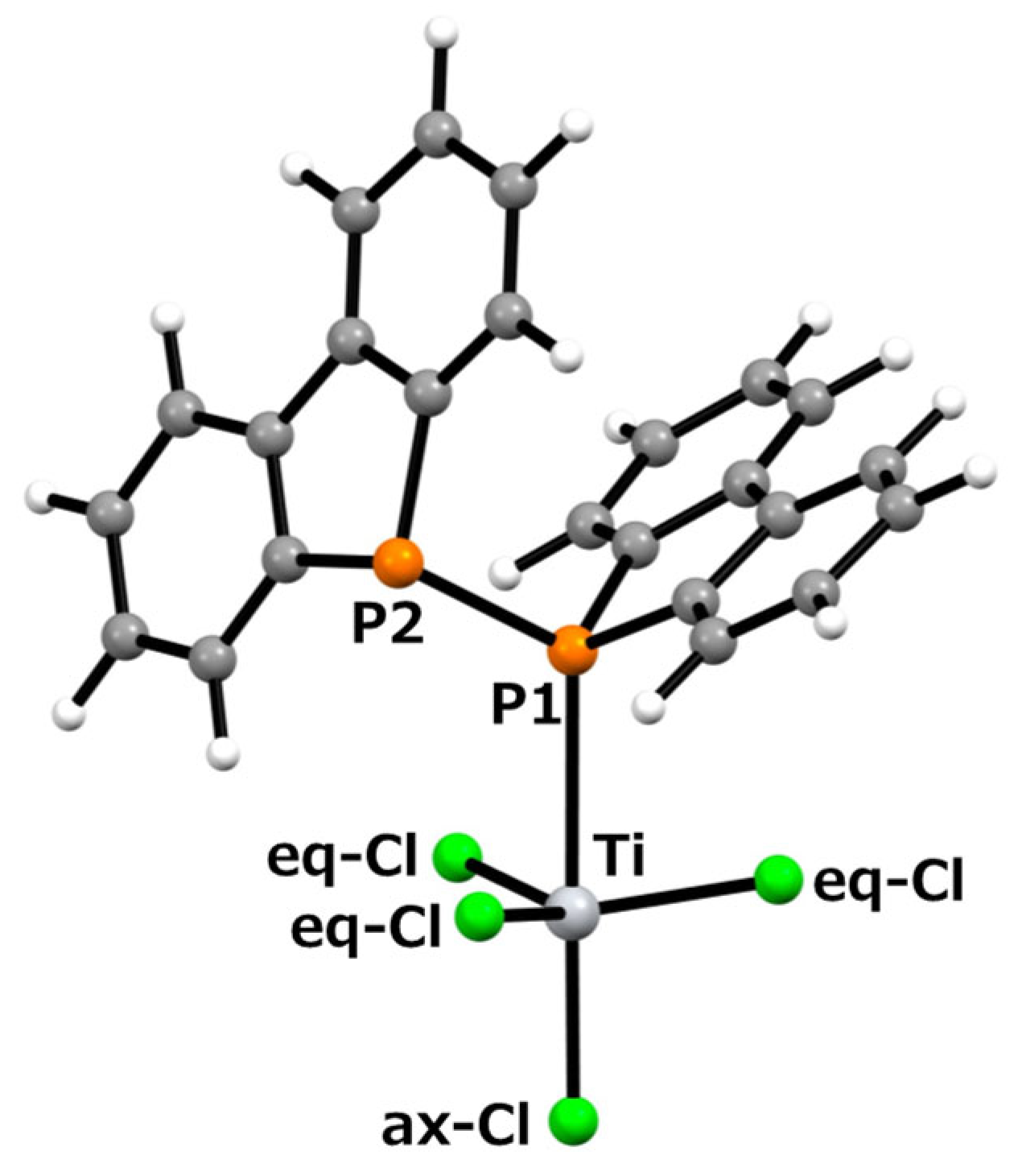
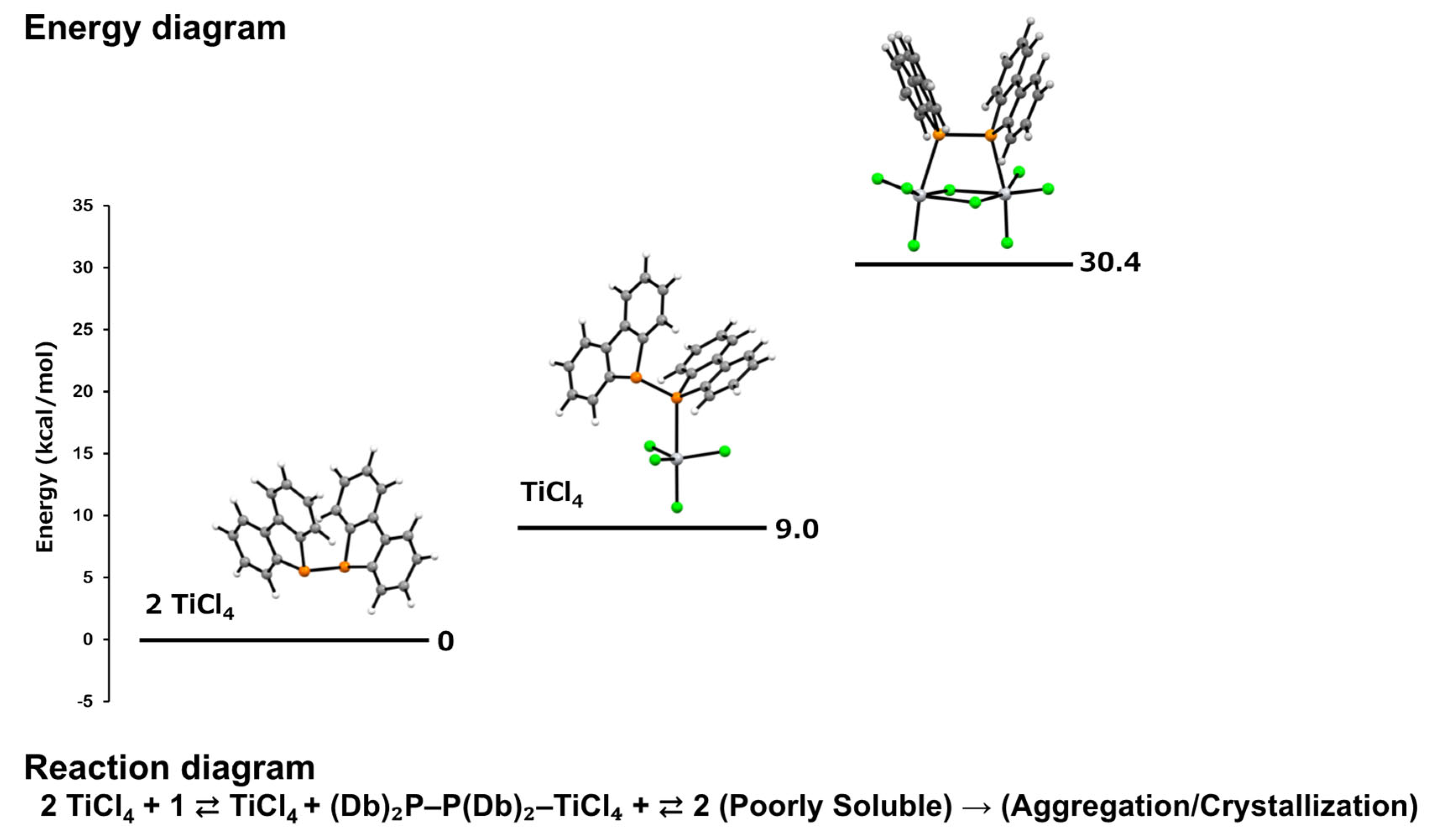
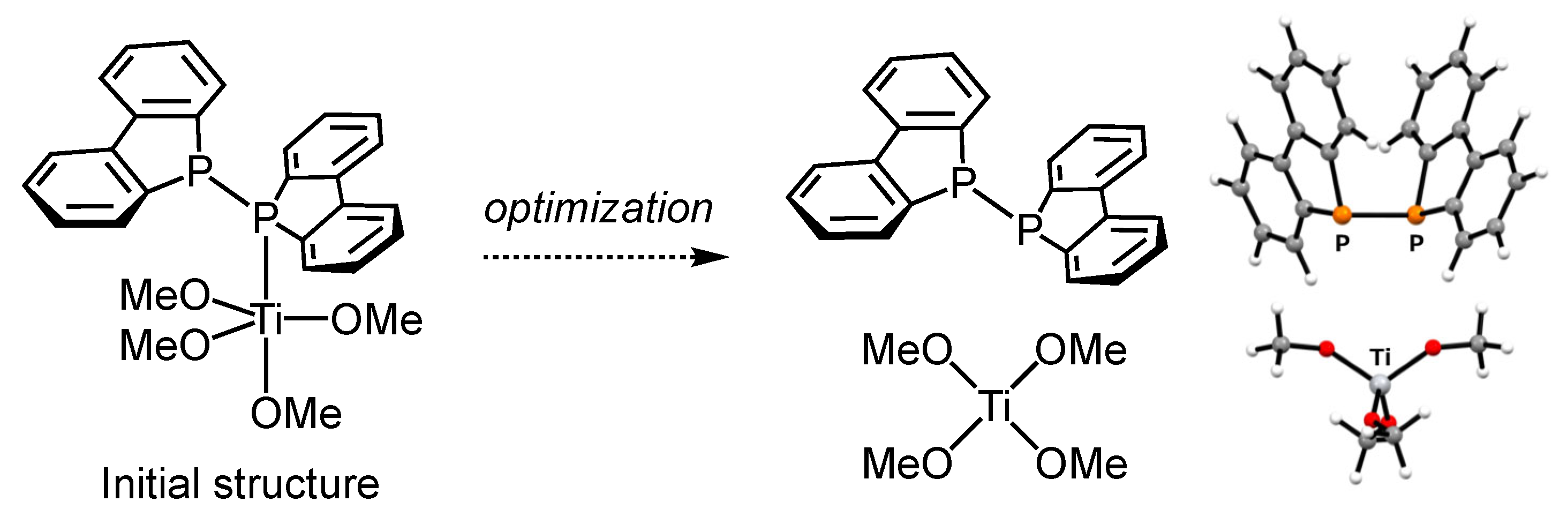

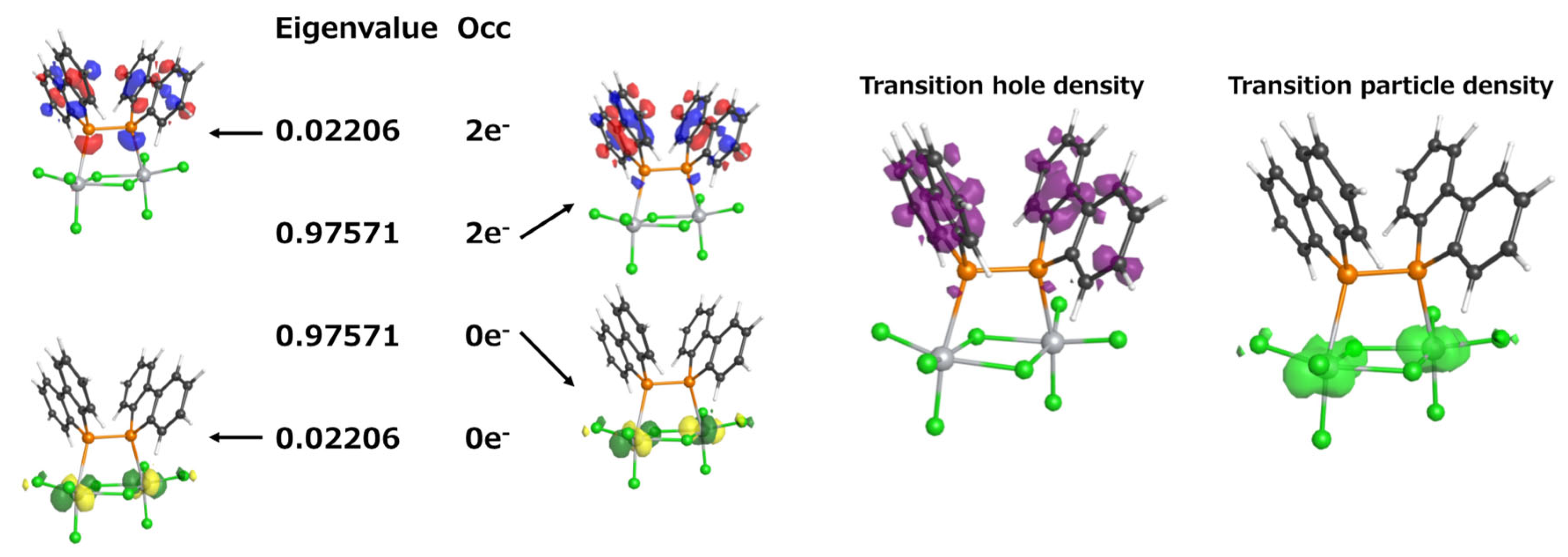
| Species | E6-311+G(2d,p) [Ha] | Gfinal [Ha] |
|---|---|---|
| TiCl4 | −2690.66339 | −2690.68944 |
| (Db)2P–P(Db)2 1 (Gauche) | −1607.24162 | −1606.96617 |
| (Db)2P–P(Db)2 1 (Trans) | −1607.23930 | −1606.96410 |
| Cl3Ti-{μ-(Db)2P–P(Db)2}(μ-Cl)2-TiCl3 2 | −6988.56430 | −6988.29663 |
| (Db)2P–P(Db)2–TiCl4 | −4297.90894 | −4297.64127 |
| ΔEbinding | ΔGbinding | |
|---|---|---|
| Cl3Ti-{μ-(Db)2P–P(Db)2}(μ-Cl)2-TiCl3 2 | 0.00411 Ha 2.6 kcal/mol | 0.04843 Ha 30.4 kcal/mol |
| (Db)2P–P(Db)2–TiCl4 | −0.00392 Ha −2.5 kcal/mol | 0.01434 Ha 9.0 kcal/mol |
Disclaimer/Publisher’s Note: The statements, opinions and data contained in all publications are solely those of the individual author(s) and contributor(s) and not of MDPI and/or the editor(s). MDPI and/or the editor(s) disclaim responsibility for any injury to people or property resulting from any ideas, methods, instructions or products referred to in the content. |
© 2025 by the authors. Licensee MDPI, Basel, Switzerland. This article is an open access article distributed under the terms and conditions of the Creative Commons Attribution (CC BY) license (https://creativecommons.org/licenses/by/4.0/).
Share and Cite
Toda, T.; Toma, Y.; Nishiguchi, M.; Takenaka, K. Synthesis, Molecular Structure, and Computational Studies of Dinuclear d0 Titanium(IV) Complex with P-P-Bonded Diphosphine Ligand. Inorganics 2025, 13, 169. https://doi.org/10.3390/inorganics13050169
Toda T, Toma Y, Nishiguchi M, Takenaka K. Synthesis, Molecular Structure, and Computational Studies of Dinuclear d0 Titanium(IV) Complex with P-P-Bonded Diphosphine Ligand. Inorganics. 2025; 13(5):169. https://doi.org/10.3390/inorganics13050169
Chicago/Turabian StyleToda, Tomoyuki, Yuya Toma, Miku Nishiguchi, and Katsuhiko Takenaka. 2025. "Synthesis, Molecular Structure, and Computational Studies of Dinuclear d0 Titanium(IV) Complex with P-P-Bonded Diphosphine Ligand" Inorganics 13, no. 5: 169. https://doi.org/10.3390/inorganics13050169
APA StyleToda, T., Toma, Y., Nishiguchi, M., & Takenaka, K. (2025). Synthesis, Molecular Structure, and Computational Studies of Dinuclear d0 Titanium(IV) Complex with P-P-Bonded Diphosphine Ligand. Inorganics, 13(5), 169. https://doi.org/10.3390/inorganics13050169







